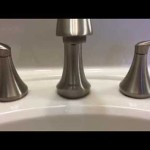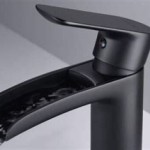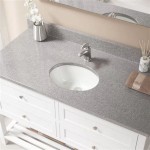Understanding the 1 ½ Inch Bathroom Sink Drain: A Comprehensive Guide
The bathroom sink, a ubiquitous fixture in modern homes, relies on a complex network of plumbing to function efficiently. A critical component of this system is the drain, responsible for channeling wastewater away from the sink and into the main plumbing lines. Among the various sizes available, the 1 ½ inch drain is a standard choice for many bathroom sinks. This article provides a detailed exploration of the 1 ½ inch bathroom sink drain, covering its components, installation process, common issues, and maintenance practices.
The selection of the correct drain size is vital for optimal performance and preventing water damage. A drain that is too small could lead to slow drainage and potential overflow, while an improperly installed drain of any size can cause leaks and structural damage. Therefore, understanding the specifications and requirements of a 1 ½ inch drain is paramount for both professional plumbers and homeowners undertaking DIY plumbing projects.
Key Components of a 1 ½ Inch Bathroom Sink Drain
The 1 ½ inch bathroom sink drain system comprises several interconnected parts, each serving a specific purpose. A thorough understanding of these components is essential for installation, troubleshooting, and maintenance.
1. Tailpiece: The tailpiece is a vertical pipe that extends directly from the sink drain opening. In the context of a 1 ½ inch drain, the tailpiece will have a 1 ½ inch diameter. It is typically made of chrome-plated brass, PVC, or ABS plastic. The length of the tailpiece can vary depending on the sink's design and the location of the drainpipe in the wall. The tailpiece connects to the drain flange that sits directly in the sink basin.
2. Drain Flange: The drain flange is the visible part of the drain assembly that sits inside the sink basin. It is a circular metal or plastic piece with a strainer or stopper mechanism. The stopper can be a lift-rod type, a pop-up type, or a simple strainer that prevents large objects from entering the drain. A rubber or silicone gasket is generally placed between the flange and the sink basin to create watertight seal. Plumber's putty can be used in addition to or instead of the gasket.
3. P-Trap: The P-trap is a curved pipe designed to hold a small amount of water. This standing water creates a seal that prevents sewer gases from entering the bathroom. Sewer gases can be harmful and have an unpleasant odor. The P-trap is a vital component for maintaining a sanitary and odor-free environment. The P-trap connects to the tailpiece at one end and to the drainpipe in the wall at the other.
4. Trap Arm: The trap arm is a section of pipe that connects the P-trap to the drainpipe in the wall. It is sloped slightly downward towards the wall to facilitate proper drainage. The length of the trap arm will vary depending on the distance between the P-trap and the wall drainpipe. It's crucial that the trap arm is properly aligned to ensure smooth water flow and prevent clogs.
5. Drainpipe (Wall Pipe): The drainpipe, also known as the wall pipe or waste pipe, is the pipe embedded in the wall that receives wastewater from the sink. It is connected to the main plumbing system of the house. The drainpipe usually has a standard diameter, often 1 ½ inches, but it could be larger depending on local plumbing codes and the overall plumbing design. Proper connection to the main plumbing system is paramount to prevent leaks and ensure efficient waste removal.
6. Washers and Nuts: Numerous washers and nuts are used to connect the various components of the drain assembly. These provide a watertight seal at each connection point. Common materials include rubber, silicone, and plastic for washers, and metal or plastic for nuts. Tightening these connections properly is crucial to prevent leaks. Overtightening can damage the components, while undertightening will lead to leaks. Using the correct size and type of washer for each connection is also very important.
Installation Process for a 1 ½ Inch Bathroom Sink Drain
Installing a 1 ½ inch bathroom sink drain requires careful attention to detail and adherence to proper plumbing practices. The following steps provide a general guideline for the installation process. It is always recommended to consult with a qualified plumber if you are unsure about any aspect of the installation.
1. Preparation: Before starting the installation, gather all necessary tools and materials, including the 1 ½ inch drain assembly, plumber's putty or silicone sealant, adjustable wrench, pliers, and a bucket. Turn off the water supply to the sink at the shut-off valves located under the sink. Also, ensure the work area is well-lit and ventilated.
2. Removing the Old Drain (If Applicable): If replacing an existing drain, carefully disassemble the old drain assembly. Use an adjustable wrench to loosen the nuts connecting the tailpiece, P-trap, and trap arm. Place a bucket underneath the drain to catch any residual water. Dispose of the old drain components properly.
3. Installing the Drain Flange: Apply a bead of plumber's putty or silicone sealant around the underside of the drain flange. Insert the flange into the sink drain opening from above. From below the sink, attach the rubber or silicone gasket, followed by the friction ring (if included), and then the mounting nut. Tighten the mounting nut securely to create a watertight seal. Wipe away any excess plumber's putty with a clean cloth.
4. Attaching the Tailpiece: Connect the tailpiece to the bottom of the drain flange. Use a slip nut and washer to secure the connection. Ensure the washer is positioned correctly to prevent leaks. Tighten the slip nut firmly but avoid overtightening.
5. Installing the P-Trap: Assemble the P-trap by connecting the U-bend to the P-trap arm. Use slip nuts and washers to secure the connections. Make sure the P-trap is oriented correctly, with the U-bend facing downward. Position the P-trap so that it aligns with the tailpiece and the drainpipe in the wall.
6. Connecting the Trap Arm to the Drainpipe: Connect the trap arm to the drainpipe in the wall using a slip nut and washer. Ensure the trap arm is sloped slightly downward towards the wall to facilitate proper drainage. Tighten the slip nut securely.
7. Final Adjustments and Tightening: Once all components are connected, make any necessary adjustments to ensure proper alignment and water flow. Tighten all slip nuts securely, checking for leaks as you go. Avoid overtightening, as this can damage the plastic components.
8. Testing for Leaks: After completing the installation, turn on the water supply to the sink. Check all connections for leaks. If any leaks are detected, tighten the corresponding slip nut or disassemble the connection and reapply plumber's putty or replace the washer. Run the water for several minutes to ensure the drain is functioning properly and there are no hidden leaks.
Common Issues and Maintenance of a 1 ½ Inch Bathroom Sink Drain
Even with proper installation, bathroom sink drains can experience issues over time. Regular maintenance can help prevent these problems and extend the lifespan of the drain system.
1. Clogs: Clogs are a common issue caused by the accumulation of hair, soap scum, and other debris in the drainpipe. Slow drainage is a typical sign of a clog. To prevent clogs, use a strainer in the drain to catch hair and debris. Periodically flush the drain with hot water to help dissolve soap scum. For existing clogs, try using a plunger or a drain snake to remove the blockage. Chemical drain cleaners should be used with caution, as they can damage plastic pipes and pose a health hazard.
2. Leaks: Leaks can occur at any of the connection points in the drain assembly. Common causes include loose slip nuts, damaged washers, and corroded pipes. To address leaks, first identify the source of the leak. Tighten the slip nut at the leaking connection. If the leak persists, disassemble the connection and inspect the washer. Replace the washer if it is cracked, worn, or damaged. If the pipe is corroded, it may need to be replaced.
3. Sewer Gas Odor: Sewer gas odor indicates a problem with the P-trap. The P-trap may be dry due to infrequent use, allowing sewer gases to enter the bathroom. Simply running water down the drain will refill the P-trap and eliminate the odor. Another cause of sewer gas odor is a cracked or damaged P-trap. Inspect the P-trap for any cracks or damage and replace it if necessary. Improper venting can also cause sewer gas to be drawn back into the bathroom. This is a more complex issue that may require the attention of a professional plumber.
4. Corrosion: Over time, metal drain components can corrode due to exposure to water and chemicals. Corrosion can weaken the drain components and lead to leaks. To prevent corrosion, avoid using harsh chemicals in the drain. Regularly inspect the drain components for signs of corrosion and replace any corroded parts. Consider using plastic drain components, as they are more resistant to corrosion.
5. Loose Connections: Vibrations and temperature changes can cause slip nuts to loosen over time. Regularly check the slip nuts and tighten them as needed. Using thread sealant or Teflon tape on the threads of the slip nuts can help prevent them from loosening.
By understanding the components, installation process, and potential issues associated with a 1 ½ inch bathroom sink drain, homeowners and professionals can ensure the proper functioning and longevity of this essential plumbing fixture. Regular maintenance and prompt attention to any problems can prevent costly repairs and maintain a sanitary and efficient bathroom environment.

Pop Up Bathroom Sink Drain 1 2

Whole 50pcs Heatgene Bathroom Pop Up Sink Drain Fits 1 2 Openi

Heatgene Bathroom Pop Up Sink Drain Fits 1 2 Opening With A 4

Luxier 1 2 In Brass Bathroom And Vessel Sink Push Pop Up Drain Stopper With Overflow Chrome Ds04 Tc The Home Depot

Traditional Sink Drain 1 2 P Trap Rejuvenation
What Plumbing Piece Is Normally Used To Transition From 1 4 Bathroom Sink 2 Drain Pipe Quora

Westbrass 1 2 In Pop Up Bathroom Sink Drain Assembly Stopper With Lift Rod Overflow Holes Exposed Satin Nickel D412 07 The Home Depot

Whole 50pcs Heatgene Bathroom Pop Up Sink Drain Fits 1 2 Openi

Oval Porcelain 20 1 2 White Top Mount Bath Sink W Overflow Drain

Snappytrap Snappy Trap Drain Kit Double Bowl Kitchen Sinks 1 2 In P Black Plastic The Under Sink Plumbing Department At Com
Related Posts







